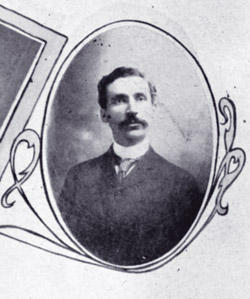
The newest addition to WSU’s outdoor sculpture collection is “Millipede”
by Tom Otterness. “Millie” now highlights the center of the original campus quadrangle at 17th Street and Fairmount Avenue — the precise section
of campus where Wichita State University had its beginning as Fairmount College.
In January 1906, the Wichita Eagle reported that Fairmount President Morrison had returned from the East and spoke in chapel. Among other items, Morrison related that Dr. P.T. Dondlinger, professor of mathematics at the college, had completed a survey of the grounds and would construct a “permanent campus plan.” The plan itself has long been lost to history, but fortunately it was described in a September issue of the Sunflower.
The campus, about 20 acres, was to be a quadrangle with Fairmount Ave.
in “about the center,” stretching north from 17th Street. Around the quad were to be campus buildings — Fiske Hall (already under construction), the library, the women’s hall, the gymnasium, the science building and the chapel.
The buildings focused inward, onto the open quadrangle, in the fashion of the New England colleges after which Fairmount was patterned.
As such, the Morrison-Dondlinger Plan departed from the first campus plan developed in 1887 by the Rev. Joseph Homer Parker, Fairmount’s founder, and the Wichita architectural firm of Proudfoot and Bird. The 1887 plan located the major buildings facing to the West, “the course of empire.” Thus, Fairmount’s main building, where construction started in 1887 and which burned in 1929, did not quite fit the new plan.
Peter Dondlinger, a Luxembourger by descent and a relative of the Dondlingers of Kansas construction fame, was only 3 when his family settled in Dakota Territory. There, Peter became a wheat shocker. In a memoir written later in his life, he admitted he did not have a “great knack” for shocking wheat.
“We had a German neighbor … whose wife did the shocking for him. It was a great source of humiliation to me. I would start practically with the binder, and be about 20 acres behind when the cutting was finished. Mrs. Blindauer would wait until 20 acres were cut before she went into action, and then would finish the field as soon as it was cut!”
At 18, Dondlinger left the homestead without having attended high school, graduated from the National Normal University in Lebanon, Ohio, taught for two years and then entered graduate school at Yale. He studied political and social science and received his doctorate in 1904. His dissertation, directed by Professor William G. Sumner, was published as The Book of Wheat: An Economic History and Practical Manual of the Wheat Industry. Published in both the United States and Europe, Wheat was for decades the most important single volume on the production and marketing of wheat.
Dondlinger began looking for a teaching position and was offered the professorship of mathematics at Fairmount College In 1904. He accepted, and taught math, astronomy, physics and surveying. During his second year, he
also taught history and Fairmount’s first sociology course.
Dondlinger had been in Wichita only a few days when “a Kansas mule rolled a buckboard” into his yard loaded
down with “Roy Kirk, Al Solter, Graham Foster and one or two other football players.” It was Kirk, of course,
who gave the Fairmount team the nickname “Wheatshockers” a few weeks later. Dondlinger noted that he
“hadn’t even seen a surveyor’s instrument in over six years,” but the players insisted that the field they had their collective eye on for football had to be plowed and leveled over the weekend. “As I climbed aboard the buckboard,” Dondlinger wrote, “the mule looked back at me with a wicked eye, and I had many misgivings.” The job, however, was a success.
Dondlinger was given another unanticipated assignment by Flora Clough, dean of women. Students who boarded
on campus ate lunch in Holyoke Hall, the women’s dormitory. Miss Clough presided over the table, and she asked Dondlinger to sit at the other end “to help keep the conversation going.” “I was naturally timid,” he wrote, “and had
so little experience in these things that I found it most difficult.”
After two years at Fairmount, he returned to Yale, completed law school and practiced in Connecticut. At WSU,
his quadrangle remains, graced by magnificent art — Miro’s “Personnages Oiseaux,” DeLue’s “Thomas Jefferson,” Goldsworthy’s “Wichita Arch” and now Otterness’ “Millipede.” One can only imagine what Dondlinger would think
of his original quad today.





